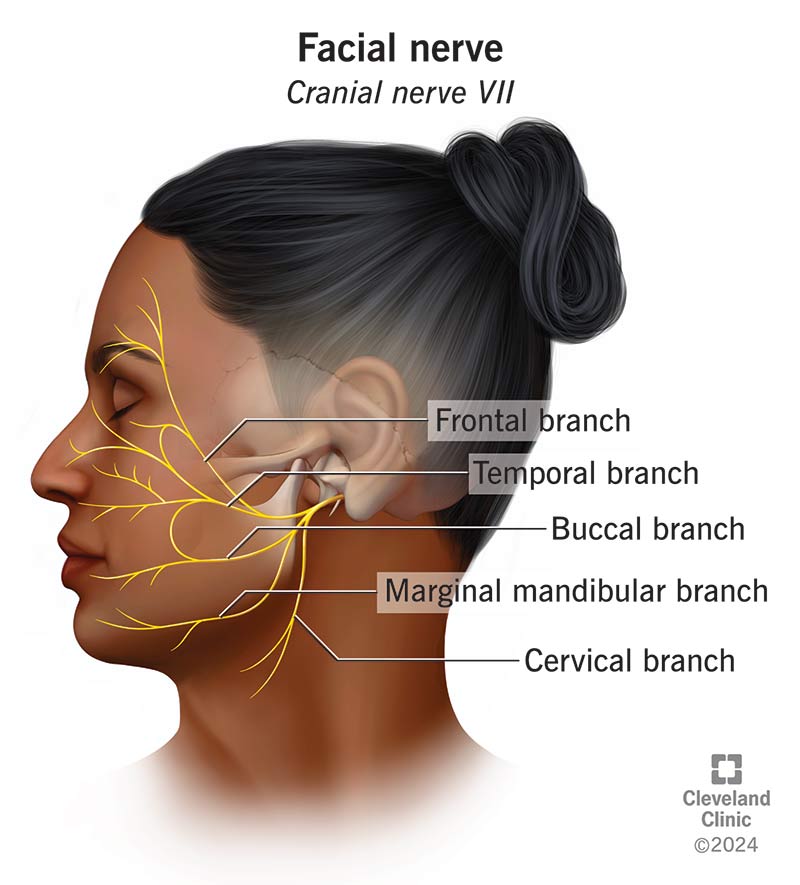Your facial nerves (seventh cranial nerves) control several muscles in your face, like the ones that help you smile, frown, wrinkle your nose and raise your eyebrows. They also have sensory and parasympathetic functions.
Advertisement
Cleveland Clinic is a non-profit academic medical center. Advertising on our site helps support our mission. We do not endorse non-Cleveland Clinic products or services. Policy

Your facial nerve, also known as cranial nerve 7 and CN VII, is a nerve in your head that sends signals from your brain to parts of your face and vice versa. You have two facial nerves, one on each side of your head. Your facial nerves are the seventh set of 12 cranial nerve pairs in your nervous system.
Advertisement
Cleveland Clinic is a non-profit academic medical center. Advertising on our site helps support our mission. We do not endorse non-Cleveland Clinic products or services. Policy
You may not be thinking about it, but your facial nerves are constantly working. They’re responsible for many important functions that make you human, like forming countless facial expressions, talking, tasting and tear production.
Your facial nerves contain motor (movement), sensory and parasympathetic nerve fibers. Each of these types of nerve fibers has specific roles.
The parasympathetic nerve fibers of your facial nerves control the salivary glands in your mouth and the lacrimal glands in the corners of your eyes. They trigger your salivary glands to release saliva (spit) and your lacrimal glands to release tears.
The sensory nerve fibers of your facial nerve play a key role in hearing. They provide innervation to your ear canal, tympanic membrane (eardrum) and outer ear (pinna). They also carry taste sensations from the front (anterior) two-thirds of your tongue.
Your facial nerve has five branches that have distinct motor (movement) functions:
Advertisement
Each of your facial nerves extends from your brain throughout your face like tree roots. The structure (anatomy) of your facial nerves:
From there, the motor branches spread out to various parts of your face and into your neck.
When something damages your facial nerve, it doesn’t function as it should. This may cause specific movement or sensory issues, depending on which nerve fibers are damaged. Several conditions and situations can damage your facial nerves, like:
When a facial nerve is malfunctioning — especially the motor (movement) functions — healthcare providers often call it facial nerve palsy. “Palsy” means “paralysis.”
Two specific types of facial nerve palsy include:
Sometimes, the motor branches of your facial nerve become overactive, leading to frequent facial muscle twitches. This condition is called hemifacial spasm.
Symptoms of facial nerve palsy (paralysis) vary depending on the cause and which part of the nerve is affected. The symptoms may be temporary or permanent. You may experience:
Advertisement
It’s important to see a healthcare provider if you have any of these symptoms. Many conditions can damage your facial nerves — some of which are serious. Your provider will diagnose the underlying cause.
You can’t always prevent facial nerve damage. But these steps can help keep your nervous system — including your facial nerves — healthy:
It’s also important to protect your head and brain from injury. Wear a helmet when playing contact or extreme sports and when you ride a bike or motorcycle.
You can thank your facial nerves for allowing you to do essential everyday things like smiling, tasting and closing your eyes. If you develop facial muscle weakness or other symptoms related to facial functions, it may be due to nerve damage. Reach out to a healthcare provider if this happens. They can do tests and assessments to see if it’s the result of facial nerve damage.
Advertisement
If you have a neurological condition, you want expert advice. At Cleveland Clinic, we’ll work to create a treatment plan that’s right for you.

Last reviewed on 07/22/2024.
Learn more about the Health Library and our editorial process.